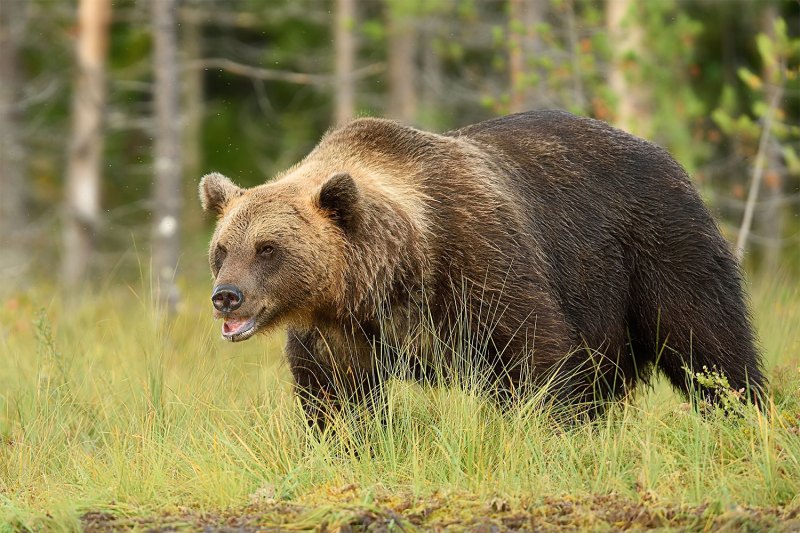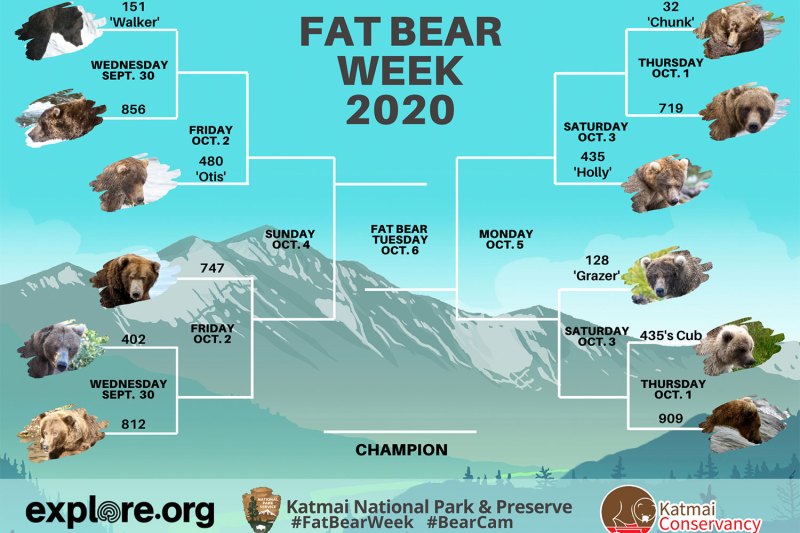Ever since the COVID-19 pandemic took away sports in March of this year (RIP March Madness 2020), fans have patiently waited for the return of their beloved basketball, football, and baseball games, which finally started happening over the past few months. While it is great to once again have sports games to enjoy, watching your favorite team play to empty stadiums with just cardboard cutouts of people filling the stands or banks of screens showing fans watching from home just doesn’t have the same energy or excitement to it.
But I’m here to tell you: If you’re finding that traditional sports in the age of COVID just aren’t your cup of tea or aren’t scratching the same itch they used to, there’s an even better sports bracket to follow along with this fall.

Get ready for Fat Bear Week!
During summer and fall, many of the estimated 2,200 brown bears that live in southwestern Alaska’s Katmai National Park & Preserve head to the Brooks River, which at this time of the year is flush with red salmon undertaking their annual run. Over the course of several months, the bears spend long days noshing on fresh fish, berries, and other foods to fatten up for hibernation through a process called hyperphagia. Around the world, viewers tune into explore.org’s livestream cam at Brooks Falls, a popular feeding area, to watch the bears in action. The bears will eat and drink pretty much nonstop to pack on as much weight as possible ahead of winter, gaining up to four pounds a day. Weight varies depending on the individual bear, their age, and gender, but in 2019, park officials estimated that the largest bear feeding at Brooks River was an estimated 1,400 pounds.
The result is hundreds of chunky bears rambling through the forests and rivers, gorging themselves on fatty fish in full view of the public, each trying to get as fat as bearly possible. And we’re talking giant-teddy-bear-at-a-carnival, look-like-they-can-barely-walk fat. Body-positive, plus-size-and-proud-of-it fat bears.
Enter Fat Bear Week, where all those rotund osos duke it out to see who has what it takes to be crowned Katmai’s Fattest Bear.
First held in 2014 and usually held from late September to early October, Fat Bear Week celebrates this annual fattening of the bears by selecting a handful of contestants and allowing people to vote for their favorites. The bears are given identifying numbers by scientists and park officials, but many also acquire nicknames like Lefty or Otis. This year, Fat Bear Week takes place from September 30th to October 6th.

Viewers vote using a March Madness-style single-elimination online bracket, where they can check pictures of the bears to see who has gained the most weight. In each round, viewers vote on their favorite fat bear and the one with the most votes proceeds to the next round. For fans who tune in year after year, it’s a great chance to see past winners and favorites, like 2019’s winner, Bear #435 or “Holly,” or multi-year champ Otis, once again vie for the title. And often, cubs from previous years that have grown up will make an appearance and be included on the ballot to try their luck. There is also the chance that fan favorites won’t come one year, with the possibility that they’re feeding elsewhere or something has happened to them. Just a part of nature.
This year, the 2020 bracket features returning favorites like Holly and Otis, as well as new competitors that haven’t yet been given names. In addition to following along with the online bracket, you can also fill out your own.
Although it’s fun to get in on the action, Katmai park rangers also say this contest and the live webcams offer valuable educational opportunities for viewers to see the bears in their natural habitat and learn more about their behaviors. Due to the high population of bears within the park, Katmai is a perfect natural laboratory for observation and study.
For new viewers eager to tune into the action, you can start now by watching the explore.org live cams and following Katmai National Park and the Katmai Conservancy on Twitter and Facebook for updates and to learn more about the bears. Once the competition starts on September 30th, you can visit the Fat Bear Week website to vote.
May the best — and fattest — bear win. After all, a fat bear is a healthy bear, so as long as they’re all stuffing their faces for winter, they’re all winners.
Go bears!



